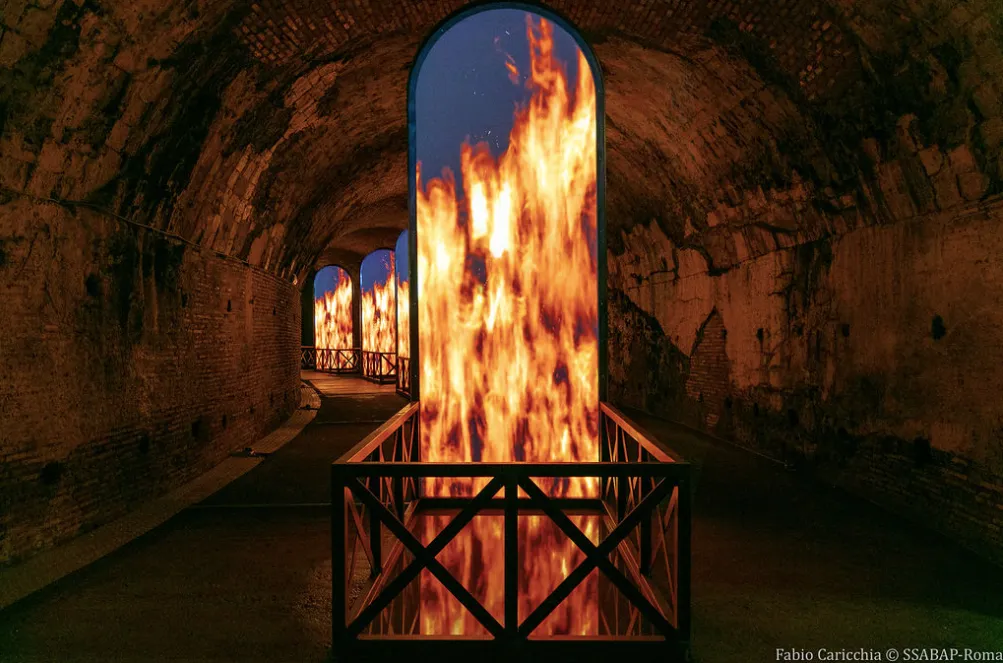You Can Now Tour the Tunnels Beneath Rome’s Baths of Caracalla
The newly opened underground network features a brick oven once used to heat the baths’ caldarium, as well as a contemporary video art installation
/https://tf-cmsv2-smithsonianmag-media.s3.amazonaws.com/filer/46/0c/460c85cb-95a4-4d29-b55b-4e764b619001/methode_times_prod_web_bin_40668c42-9113-11e9-b2d4-5918cdd6778e.jpg)
During the 3rd century A.D., Rome’s Baths of Caracalla welcomed some 5,000 visitors daily. The enormous complex—the second-largest in the history of the Roman Empire—included three bathing sections of varying temperatures, a natatio or swimming pool, two gyms for wrestling and boxing, restaurants, libraries, and even waxing salons.
Beneath the baths’ sumptuous aboveground attractions, slaves toiled in a roughly 2-mile-long, 6-mile-wide network of underground tunnels, transporting carts of wood to the 50 brick ovens responsible for keeping the building’s caldarium (a domed room containing seven 39-foot plunging pools) at a constant temperature of 104 degrees Fahrenheit.
A stretch of this labyrinthine opened to the public in 2012, but as Tom Kington reports for the Times, a section of the tunnels revealed earlier this week is the first to feature one of the surviving brick ovens.
“This is the technological heart of the baths,” Marina Piranomonte, director of the site, tells Kington. “Everyone should see it—not just academics with torches” (or flashlights, as they’re called on this side of the Atlantic).
The newly opened subterranean space embraces both Caracalla’s historical legacy and contemporary video art, as represented by an ongoing exhibition titled Plessi at Caracalla: The Secret of Time. On view now through September 29, the show is the brainchild of artist Fabrizio Plessi; curated by Alberto Fiz and set to music by British composer Michael Nyman, the display consists of 12 sculptural installations inspired by the baths, the “cruel, capricious, murderous, wilfully uncouth” emperor whose name they hold (in the words of Ancient History Encyclopedia’s Patrick Hurley), and the imagery of elemental forces such as fire and water.

The synchronized videos depict everything from flickering flames to a sculpture of Emperor Caracalla’s head. According to the Italian Informer’s Gabriel Barrie, the show “claims, against the trends of modern technological advance, that the best way to understand these places is not through video reconstruction or virtual reality.” Instead, “it is through the human experiences of ... light and dark, stone and water, sound and space.”
In an interview with Marzia Apice of Agenzia Nazionale Stampa Associata, Rome’s special superintendent, Francesco Prosperetti, says that Plessi’s installation underscores the “drama of a place where thousands of slaves … worked to maintain a perennial fire.”
Speaking with the Times’ Kington, Piranomonte, the site’s director, also emphasizes slaves’ centrality to the baths’ everyday operations. As she explains, these men and women burned tens of tons of wood per day, keeping the fires stoked all night in order to ensure the caldarium was ready for the morning’s visitors. Every second of the day, a nearby aqueduct delivered 18.5 gallons of water—the equivalent of the amount of water consumed today by the city of Siena—through a cistern and into copper tanks subsequently heated by the tunnels’ 50 brick ovens.
Given the fact that this process relied heavily on lead pipes, Piranomonte says it’s possible that the toxic element entered the baths’ water supply and slowly poisoned visitors.
“But don’t blame that for the decline of the Roman Empire,” she quips. “It simply declined because it got too big.”
The Baths of Caracalla survived for more than 300 years, only closing in 537 A.D. after invading Witigis forces destroyed the city’s water supply. Eventually, the imposing complex was stripped of its marble and fell into ruin. Thanks to the $392,000 USD restoration campaign, however, tourists can now explore the space, roaming the baths’ still-standing walls and the extensive network of tunnels hidden below.
/https://tf-cmsv2-smithsonianmag-media.s3.amazonaws.com/accounts/headshot/mellon.png)
/https://tf-cmsv2-smithsonianmag-media.s3.amazonaws.com/accounts/headshot/mellon.png)